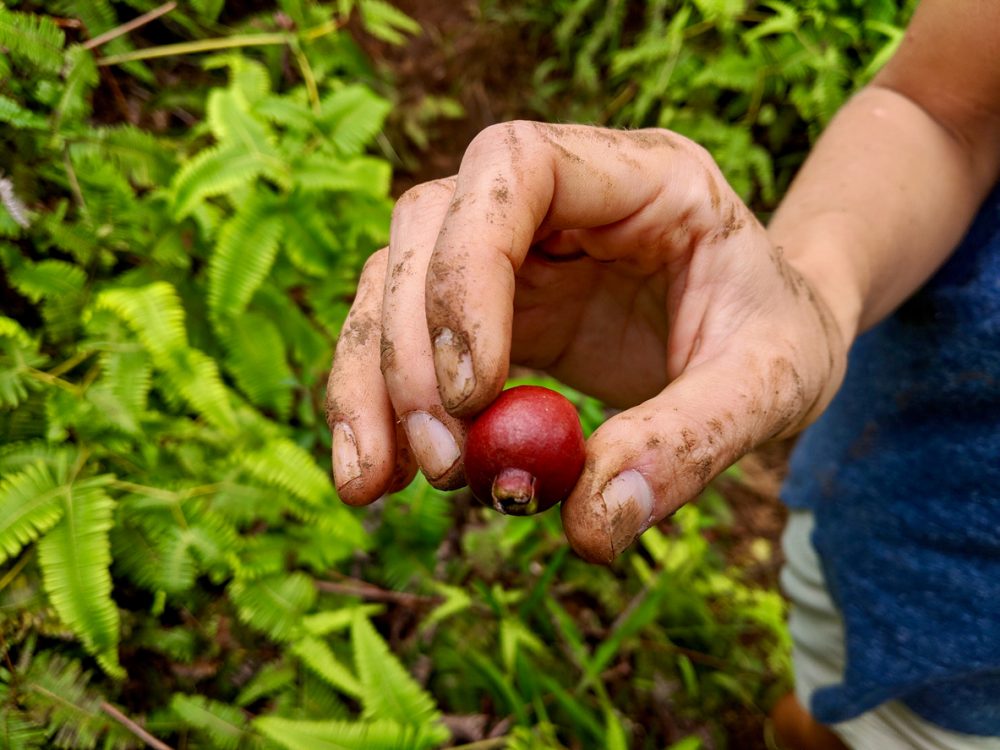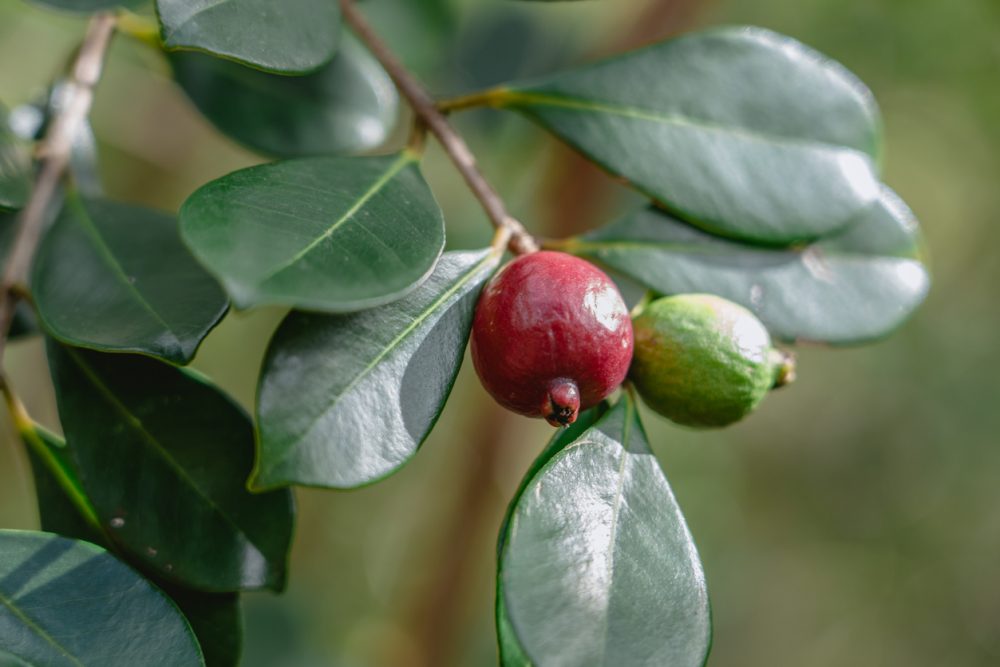Strawberry Guava Care: How To Grow A Strawberry Guava Plant
Some people love strawberries. Other people are passionate about guava. But what if you could have a plant that got the best of those two fruits in one juicy and delicious compact package? This is no magic or sci-fi. It’s a real shrub called Psidium cattleianum or strawberry guava for the layperson. Other names include Cattley guava, Cherry guava.
But whatever name you choose to call it, there’s no denying it’s one of the most exotic fruits to come out of South America. And what’s not to like. This Brazilian native has a beautiful silhouette like a Samba dancer, with a reddish-brown bark full of intricate patterns and lush foliage that takes your breath away. And did we mention that the fruits are packed with flavors and as sweet as they come?
Apart from their low-maintenance quality, strawberry guava plants are easy to grow, and their shallow roots make them suitable to plant just about anywhere. You can use it either as a border shrub, a landscaping plant or just grow it for its delicious fruits. The quaint white flowers are the cherry on top of the cake.
Varieties of Strawberry Guava
While you can consider the strawberry guava as an all-purpose plant that has got it all, you don’t have to limit yourself to just one species. In fact, the tropical forests of South America are abundant with other varieties that you can choose from or mix and match to create a lush landscape in your tropical garden. Even though there are no known cultivars of this specific species, some of its natural varieties include,
- Psidium guajava: also known as lemon guava and common guava. This shrub is native to the Caribbean and Central America, with a height between 10 to 15 feet. It’s not as hardy or lush as strawberry guava, although the fruits are just as juicy.
- Feijoa or Acca sellowiana: known among the locals as pineapple guava, it’s grown both as an ornamental plant and for its tart and flavorful fruits. The tree grows to 12 feet but has a wider spread than the lemon guava. It also produces fruit quicker than the other species. They are hardy plants with high tolerance to frost and low temperatures.
- Psidium cattleianum: the strawberry guava goes by many other names and was named after horticulturist William Cattley; it’s a common plant in Hawaii and averages between 6 to 18 feet when fully grown. The white flowers, deep foliage, and sweet-flavored fruits make it a favorite of many gardens in the warm southern parts of the country, from Florida to Southern California.
How to Grow Strawberry Guava
As far as planting strawberry guava is concerned, you have two options, either use seeds or shoots. The most common way for gardeners to plant it is by using shoots. It’s birds that spread the seeds around, Something that Hawaii has had a problem with for years. You can order the seeds online or get the shoots from a nursery. Here’s how to plant strawberry guava in easy steps.
- The best time to plant the seeds is in the late spring after the last frost. That’s when the soil is warm enough and easy to work.
- Make sure you can replicate the tropical habitat of its native land in Brazil. A lawn, garden, or backyard all do. Just be wary of its appetite to spread around as it is an invasive species. As long as it gets plenty of sunlight.
- Check the pH in the soil not to exceed 7. Strawberry guava flourishes in rich and loamy soil.
- Plant the seeds a half-inch deep and water immediately. The temperature should be between 70 to 85 degrees F at all times to ensure germination.
- After between 4 to 6 weeks, the seeds will germinate, and small roots take hold in the soil. If the soil is not good enough or the temperatures fluctuate, it could take up to 12 weeks for germination.
- Keep the temperature steady, and humidity levels high until the plant takes root and leaves appear.
- The fruits take anything between 3 to 5 months to ripen and be ready to harvest.
Care for Strawberry Guava
Whether you grow your strawberry guava for ornamental purposes as a stand-alone tree in your backyard, as a landscaping hedge, or for its fruit, one thing is sure, it takes a bit of work to make sure your shrub grows healthy, strong, and fruitful.
Soil and Fertilizer
As with many fruit plants that grow in the tropics, the best soil is one that is both rich and loamy. If you have compact or dark soil, add sand to loosen it up for the shallow root system of the strawberry guava to grow and spread. The pH levels should be between 5 and 7. If it’s higher than that, the plant will not grow as well as expected. Mix plenty of organic matter in the soil to improve water retention, aeration, and give the shrub the nutrients it needs.
Fertilizers are important for the success of this plant. A well-balanced fertilizer such as a 6-6-6 would do nicely. Apply fertilizers three times a year. Once in the spring, another in the early summer once the flowers bloom, and a third time when the fruits appear.
Temperature and Light
As native to the tropical forests, strawberry guava relishes high humidity and plenty of sunlight. A shady corner in your yard won’t do since this plant needs full sun and at least 6 hours of exposure to grow. While it can tolerate colder climates, it thrives in the warm and humid regions, similar to the weather in Florida. It’s best to maintain a temperature between 75 and 80 degrees F throughout the growing season. If you have no control over the weather, you can grow it in a greenhouse where both the humidity and temperature are steady all year round.
Water
Water is literally the lifeline of the strawberry guava. As we all know, its original habitat is known for its long rainy seasons. So you need to irrigate the plant regularly and make sure the soil doesn’t go dry. While a short drought will not have a lasting impact on the shrub, you’ll notice its effects on the fading leaves and smaller than usual fruits. Increase the watering during the fruit season but also during the growing cycle in the spring and summer. Once the plant reaches maturity, you can cut the irrigation down to once a week.
Pruning
As is the case with all invasive shrubs, you need to be diligent with your pruners or clippers at hand. While, for the most part, the strawberry guava doesn’t grow out of shape fast, it has a tendency to spread and propagate at alarming rates. If you’re growing it as an ornamental tree, then you need to keep an eye out for any unruly branches or twigs growing out of shape.
Pest and Diseases
Thanks to their fruits and rich foliage, the strawberry guava acts as a magnet for birds, squirrels, and other critters drawn to its fruits. While it’s easy to deal with these nuisances, other pests pose a clear and present danger to the health and wellbeing of the shrub.
Among its most invasive and pervasive pest, root-knot nematode black scale, ants, and fruit flies take the cake. You can use insecticides to get rid of them, but don’t spray the fruits or flowers. The plant is also prone to algal leaf spots, an infectious disease that causes the leaves to look sickly and develop spots. Remove the infected leaves and burn them immediately.
Harvesting And Storing
In the spring, the flowers bloom on the strawberry guava, which is a sign the fruits will soon follow. After the flowers pollinate, they fade and make way for the fruits. These take anything from 3 to 5 months to ripen, depending on your weather and soil condition. When they are ripe, it’s time to harvest them. Don’t leave them on the tree for long as they rot easily, and squirrels would steal them.
You can store the fruits in the fridge for up to 5 weeks if they’re not fully ripe. But ripe strawberry guava needs to be processed almost immediately. You can use it to make jams, pies, or eat it fresh.
Benefits and Uses of Strawberry Guava
Both the fruits and leaves of the strawberry guava have their medicinal benefits. In addition to the sweet fruits, landscaping designs, and beautiful blooms, science has found many uses for this humble shrub.
The reason the pharmaceutical industry took an interest in the plant is its recently discovered anti-microbial, antiseptic, and antibacterial properties. It has considered a good source of fiber which helps with digestion. The fruits are rich in vitamin C and help wounds heal faster.
Related: Composting With Coffee Grounds – Use Coffee Grounds In Your Garden
And last but not least, the seeds of the fruit can be a good substitute for coffee beans. This is especially good news for people who like coffee but not caffeine. You can roast and grind the seeds to get a rich flavored brew that tastes much better than decaffeinated coffee.

